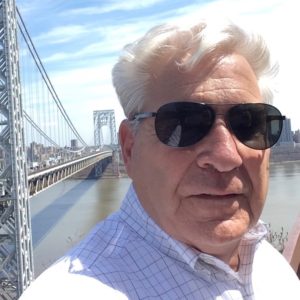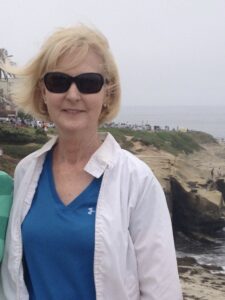About the Boat
The Motor Vessel Big Enough is an Offshore 48 Pilothouse Trawler built in 2001 and powered by two Caterpillar 3208 diesel engines. Below deck, she has two staterooms. The owner’s stateroom is mid-ship with a walk-around queen berth and en-suite head. The VIP berth is forward, also with a queen pedestal berth and en-suite head. There are three helm stations, one in the pilothouse, one on the fly bridge and one in the aft cockpit which makes stern-in docking easier. There are thrusters fore and aft. An auxiliary 12 kW diesel generator provides AC power for the four air conditioners and galley appliances while anchored. Three fresh water tanks hold 285 gallons and two fuel tanks hold 300 gallons each. We cruise her at an average speed of 8 knots burning about 5 gal/hr. That gives her a comfortable cruising range of over 900 miles. She draws 4’9″ of water with an air draft of 20′ at the anchor light which is hinged to reduce the air draft to less than 19′.
About the Name
We love seeing boat names with a backstory. Here’s ours. We completed our first loop on our Heritage East 36′ Hearken. It was a perfect boat for the mostly protected waters we traveled. On some of the legs, especially in open water, the pitch and roll ride could be less than relaxing. After completing the loop, like many gold loopers, we went into loop withdrawal. What do we do now? We decided that the Down East Circle Route should be our next water adventure. But, to be comfortable, the boat needed to be wider and heavier. Stabilizers would be nice. We felt Hearken just wasn’t big enough.
When Admiral Mindy was a very young girl living in Sedona, AZ, she spent some time on a cattle ranch. The horse she rode was eventually gifted to her by the rancher. Its original owner was a man of large stature who was too big for this horse. He gave it to his wife and said “This horse isn’t big enough for me, but its big enough for my wife.” The name ‘Big Enough’ stuck.
So now we’ve come full circle; from a horse that wasn’t quite big enough, to a sundeck trawler that wasn’t quite big enough, to the boat we will take onto the bigger water of the Down East Circle Route and beyond. It’s our stabilized Offshore 48 Pilothouse, appropriately named “Big Enough.”
About the Route
We completed our America’s Great Loop on Hearken when we crossed our wake at Sister’s Creek in Jacksonville, FL. Our route and side trips included the Atlantic ICW north from Jacksonville, The C&D canal and Delaware River to Cape May then outside to New York Harbor. Then through the Hudson River Valley to Waterford and the eastern Erie and Oswego canals to Lake Ontario. Then down the Saint Lawrence, through the five large locks to the Ottawa river junction, and up to Ottawa through the 8 stair-step locks and down the Rideau Canal to Kingston. Our next season took us through the Trent-Severn and north channel of Lake Huron and down the eastern side of Lake Michigan to Chicago. We continued down the inland rivers (Cumberland, Illinois, Mississippi, Ohio and Tennessee) to Pickwick Lake with a side trip to Chattanooga before wintering the boat at Iuka, MS. We began our third cruising season with a side trip to the headwaters of the Tennessee River and the navigable waters of the Little Tennessee. Then we traveled the Tom-Bigbee to Mobile, then along the gulf coast to Carrabelle and across the gulf (at night) to Tarpon Springs. After reaching Fort Meyers, we turned east to Stuart and then north to complete our loop at Sisters Creek in Jacksonville. We sold Hearken in Jacksonville and took possession of Big Enough (formerly known as End of the Rode) in the same marina. We moved her up the AICW to spend the winter in Virginia. Now we are retracing much of the route we covered on our original loop as far as Oswego. From there its the opposite direction through the Rideau Canal past Ottawa and on to Montreal. After that it will be all new to us. We are looking forward to Quebec City and maybe some whale sightings. In preparation for the Maritime provinces, Nova Scotia and the coast of Maine, we’ve been studying the available literature and learning a little French.
About the Crew
The primary crew size is only two, occasionally augmented by overnight guests, so all the responsibilities of a standard ship’s company are shared. While Bill may be the Captain, his duties include: Navigator, Boatswain, Machinists Mate, Yeoman, Helmsman, dinghy Coxswain and bar tender. Mindy is the XO (Executive Officer) and on a looper boat holds the honorary rank of Admiral. Her duties include: Ship’s Bursar, Cruise Director, decorator, and line handler, as well as Helmsman. She is also the de facto naval architect since she specified the major technical features of both boats we have owned.
 Captain Bill, a native of Hasbrouck Heights, NJ was first enlisted in the US Navy and then commissioned in the US Air Force where he flew twin-engine jets and the eight-engine B-52. That experience provides a skill-set of navigation and relative motion understanding that translates directly to boat handling. As a youngster, he sailed small boats on Greenwood Lake, NY and fished “the rip” from a small boat off of Montauk Point, Long Island. He also sailed small boats on Guantanamo Bay, Cuba and a 36’ sailboat on the waters off the coast of San Diego, CA. As a “mostly” retired Executive Consultant for the nation’s leading Capture Planning and Proposal Development firm, he has downsized to be “Storyteller Emeritus” and now consults mostly over cocktails on the dock.
Captain Bill, a native of Hasbrouck Heights, NJ was first enlisted in the US Navy and then commissioned in the US Air Force where he flew twin-engine jets and the eight-engine B-52. That experience provides a skill-set of navigation and relative motion understanding that translates directly to boat handling. As a youngster, he sailed small boats on Greenwood Lake, NY and fished “the rip” from a small boat off of Montauk Point, Long Island. He also sailed small boats on Guantanamo Bay, Cuba and a 36’ sailboat on the waters off the coast of San Diego, CA. As a “mostly” retired Executive Consultant for the nation’s leading Capture Planning and Proposal Development firm, he has downsized to be “Storyteller Emeritus” and now consults mostly over cocktails on the dock.

XO Admiral Mindy, born in New Braunfels, TX, grew up in Sedona, Arizona. Horses were always her thing and that’s why both of our now grown children continue to have a strong equestrian influence in their lives. She has held senior positions in the banking industry and within the Bursar’s organization at the University of California, San Diego. For the majority of her career, she was the Director of Finance and Planning for Scripps Institution of Oceanography in La Jolla, CA and managed a multi-million dollar budget that included a fleet of seven globally-deployed research ships. Now, with a much smaller budget and fleet of only one, she still keeps a close watch on the bottom line… and the Captain.